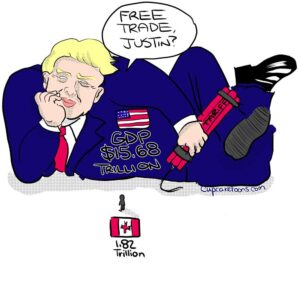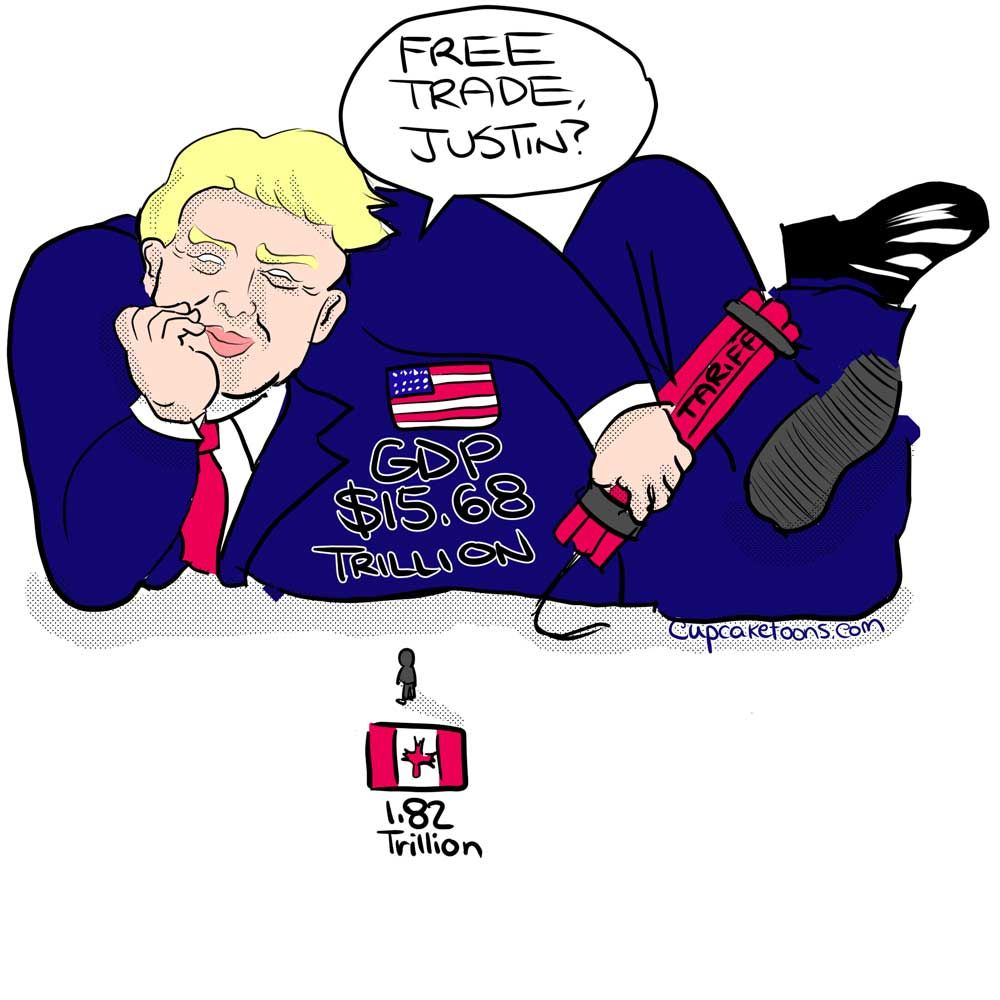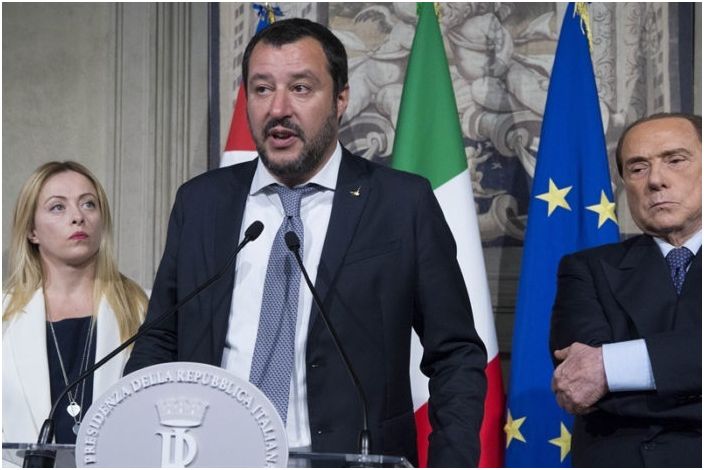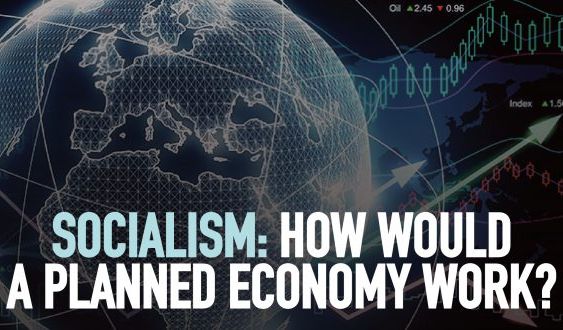 So after a lot of fanfare, seemingly hard bargaining down to the wire, the media consensus is that Trudeau got the best possible deal for “Canada.” The point about any trade deal is that it is mainly about reconciling the interests of competing capitalist classes, not what is best for the working people of the countries involved. So when they talk about “Canada” making concessions on this or holding firm on that, what they are actually talking about is how the interests of one capitalist sector vis-a-vis the interests of another were juggled around – all in the name of getting a deal for “the country.”
So after a lot of fanfare, seemingly hard bargaining down to the wire, the media consensus is that Trudeau got the best possible deal for “Canada.” The point about any trade deal is that it is mainly about reconciling the interests of competing capitalist classes, not what is best for the working people of the countries involved. So when they talk about “Canada” making concessions on this or holding firm on that, what they are actually talking about is how the interests of one capitalist sector vis-a-vis the interests of another were juggled around – all in the name of getting a deal for “the country.”
The name of the agreement has changed (new bottle of USMCA) but the agreement is essentially the same (old wine of NAFTA). And on the “what’s in a name” theme, it’s worth noting that “US” had to come first in the abbreviation/acronym for both Trump’s ego and to signify who was really driving the bus. If Canada had been second, the acronym would be USCAM, which is too close to the truth about the deal. In reality it is a scam to benefits corporations at the cost of workers, consumers and the environment.
Mitch Potter, Toronto Star journalist put it well:
“Imagine if Donald Trump decided it was high time the National Hockey League changed its name to something that would make America great again. Goodbye NHL, hello AFHL – the America First Hockey League.
“The game would remain the same, for those who don’t mind star-spangled tweaks. A few more American flags here and there, the inevitable chants of “USA! USA! USA!” But otherwise no changes of deep significance.
“Canada’s world-leading hockey supply chain would continue apace, meeting close to half of the league’s playing needs. American fans, with 24 teams to Canada’s seven, would continue paying most of the freight, making multimillion-dollar superstars of kids from places like Cole Harbour, NS, as they do now.
“But Canadians would still be screaming bloody murder over a grotesque, identity-stealing violation of sovereignty.
“Which is why it is such a good thing none of us ever cared in the least about the bloodlessly boring acronym NAFTA. Because in rebranding what is essentially the same trade deal we’ve had for decades with a new name, USMCA – notice how it puts America first and Canada last – Trump is walking away with the nativist-pleasing yet entirely meaningless fist-bump he was looking for.
“In surrendering on a rebranding that literally names America first, Canada and Mexico made a zero-sum call that US President Donald Trump can present as a win at a cost of literally nothing in real dollars.”
The Washington Post reported “A handful of major industries scored big wins . . . at times at the expense of ordinary consumers in the United States, Canada and Mexico. The winners include oil companies, technology firms and retailers, but chief among them are pharmaceutical companies, which gained guarantees against competition from cheaper generic drugs. The gains underscore the benefits US industry will be seeking, and the pressure it will exert, as the Trump administration continues rewriting trade deals with other countries and regions. Lobbyists for several industries said they hoped USMCA would serve as a yardstick for future US trade deals, including any involving China.”
The Toronto Star editorial, while praising the deal as “Canada holds its own,” made this valid comment: “it’s notable that the words ‘free trade’ appear nowhere in the new name. The very phrase has become synonymous with ‘lost jobs’ in rust belt states that saw factory jobs migrate to Mexico under NAFTA. This is frankly about managed trade and political branding. Count that as a big win for Trump.”
Of course, the devil is in the details, so let’s look at the deal itself in its different aspects.
Auto, Steel, Retail and Oil
The autoworkers (Unifor) were relatively happy as the deal seems to offer some of the same and some more for the auto sector. There will be a change to auto tariffs, so that, as of 2020, a car will qualify for tariff-free treatment if 75% of its contents are made in North America (an increase from the current NAFTA threshold of 62.5%). In addition, 30% of the content must be produced by workers earning at least US$16 an hour. This will increase to 40% in 2023. The wage is more than three times what the average Mexican autoworker earns now. It’s worth noting that this issue began as a Trump demand aimed not at showing solidarity with poorly paid Mexican workers but at appealing to many of his own working-class supporters who were understandably concerned about the disappearance of US manufacturing jobs under NAFTA. However, while higher Mexican wages may discourage auto makers in Canada and the US to relocate to Mexico, the new rules could create strong incentives for American and Canadian auto makers to move to Asia.
While Jerry Dias, Unifor President, was smiling, steelworkers were not smiling. Their union described it as a sell-out of Canadian steel and aluminum workers on the grounds that the deal failed to remove the damaging tariffs on Canadian steel and aluminum imposed by the Trump administration in June.
Then there is the issue of how goods are shipped to Canada. The Toronto Star reported that “Canadians will pay less in duties and taxes on some goods shipped to them from US retailers under the new trade deal announced Sunday – but only if they don’t use Canada’s national mail carrier to ship them.” Mike Palecek, President of the Canadian Union of Postal Workers, was clear on what this means: “This is an attack on the postal service. It is privatization by stealth. They are trying to starve Canada Post of parcels and send them to the private sector.” (Facebook post)
For the US oil industry, which was worried that Mexico’s incoming president, Andrés Manuel López Obrador (AMLO), would restrict the recent wave of foreign ownership in the energy sector, the deal provided new assurances. AMLO has at times criticized this foreign investment that poured into Mexico after foreign companies were allowed to invest in oil exploration and production in 2013. He has not offered much clarity on whether he will strike new deals with foreign companies but has said he intends to respect the more than 100 contracts already signed with companies including ExxonMobil, Chevron and BP. Thanks to lobbying by the energy industry, USMCA allows oil and a few other industries to continue using a special dispute-resolution process from the original NAFTA agreement in their dealings with the Mexican government.
The Environment: Climate Change? What’s That?
USMCA does not mention the terms “climate change” or “global warming” and contains no binding rules on air pollution. The US Sierra Club says the deal “includes weak environmental terms that have historically enabled outsourcing of pollution and jobs, fails to make any mention of climate change, and includes special handouts to oil and gas corporations. Much of the language appears designed to greenwash the deal, not to rectify NAFTA’s threats to wildlife, ecosystems, or clean air and water.”
Apparently, the Trudeau government “absolutely did” try to get climate change written into the new trade deal, according to Environment and Climate Change Minister Catherine McKenna. But she said she didn’t consider the absence of the term to be a big loss for the Canadian side, as she believed the USMCA’s environment chapter “is very clear on each government’s rights to regulate to protect the environment. It’s a negotiation. The US has taken a different position when it comes to climate action, and let me be clear, we are going to continue taking ambitious climate action.” (Source: National Observer, October 2). The Liberals will continue to talk a lot about action on climate change and do very little (a modest and ineffective Carbon Tax) or even boost climate change, by pushing for new pipelines.
On the plus side, the deal does away with a requirement that Canada export a constant proportion of its oil and gas to the US. That clause, dating back to the pre-NAFTA 1989 Canada-US Free Trade Agreement, was added at the behest of the petroleum industry in order to prevent future Canadian governments from pursuing nationalist energy policies aimed at self-sufficiency. This has interfered with the government’s ability to scale back carbon emissions and fight climate change. But this is small potatoes when one considers the other elements of Trudeau’s environmental policies. The Council of Canadians commented that “while there is an environmental chapter, nothing refers to the Paris agreement, so the chapter is relatively weak. The agreement makes some reference to pollution, marine traffic, endangered animals, ozone, etc, but not to global warming. The labour chapter and the environment chapter both suffer from weak enforcement. While the government will say that it is binding, it is only enforceable in the event that existing laws actually affect investment.”
Big Pharma
The pharmaceutical industry won stronger protection for sales of so-called biologic drugs, which are typically derived from living organisms and are administered by injection or infusion. The medicines are among the most costly and innovative on the market and are a major driver of drug spending. USMCA guards new biologic drugs from cheaper generic competition for at least ten years, compared with current protection of eight years in Canada and five years in Mexico. “By increasing the term to ten years, there will be less competition and higher prices,” said Valeria Moy, an economics professor and the director of Mexico Como Vamos, a think tank in Mexico City. “Having more protection in that area means higher prices for consumers.” (Washington Post)
The Dairy Industry
This was supposed to be the big concession made by Canada to pacify Donald Trump. The US has repeatedly complained about the unfairness of Canada’s protection of its dairy industry with its supply management system, a classic case of the “free” market being managed by governments to protect a certain sector of producers. It works on the basis of farmers managing “their production so that it coincides with forecasts of demand for their products over a predetermined period – while taking into account certain imports that enter Canada, as well as some production which is shipped to export markets. Imports are controlled using tariff rate quotas. These allow a predetermined quantity to be imported at preferential tariff rates while maintaining control over how much is imported.” (Wikipedia)
The US got its way, forcing Canada to yield a larger market share to American dairy farmers. Canada also made concessions in poultry and eggs. Not wanting to lose an important electoral base, the Liberals have promised to introduce subsidies and farm income protection schemes that Canadian taxpayers will have to pay for. It remains to be seen how this protection will work – will it support already wealthy Canadian dairy farmers or will it help to protect low paid workers on the farms who face a potential loss of jobs as a result of the Canadian concession?
Investor-state Dispute Settlement (ISDS) gone and Chapter 19 Stays
The ISDS process or Chapter 11 of NAFTA was a provision that allowed companies to launch trade challenges against governments, which they believed had unfairly regulated against them. This allowed companies to block laws to protect the environment or public health. The Council of Canadians commented “for years, Canada has faced corporate lawsuits that made provinces renounce public auto insurance, accept toxins, and pay for refusing dangerous quarries. Now, at the request of the US, there will be no ISDS process between US and Canada. Canada is the most sued country under ISDS with 37 cases, mostly by US companies. The US has only faced 21 cases and has never lost one.”
These cases were not heard in a court but rather were decided by panels of appointed and unaccountable corporate lawyers and other representatives of big business. ISDS will be phased out over the next three years leaving US companies a window to further sue the Canadian and provincial governments.
Then there’s Chapter 19, the retention of which the Liberal government touts as one of its biggest victories in the USMCA. This allows bi-national panels (again usually appointed corporate lawyers) rather than a domestic court to review issues related to imposed tariffs or “dumping” whereby a country’s businesses lower the price of their exports, sometimes below the actual cost of production, to gain “unfair” market share. The system had not been used heavily in the last 10 years. In the US-Canada context, the best known case was in the mid-2000s on the issue of softwood lumber. Chapter 19 panels repeatedly ruled against the US, before the Canadian government cut a deal that temporarily ended the dispute.
Copyright Changes – another Canadian Capitulation
Canada’s Copyright Act provides that the term of a copyright is the life of the author plus 50 years. Under the USMCA, Canada is required to extend copyright protection to the life of the author plus 70 years. Michael Geist, Canada Research Chair in Internet and E-commerce Law, observed: “We’ll find that Canadian culture and heritage is locked down, out of the public domain for an extra two decades. Canada had resisted those reforms despite US pressure for a long time … (It) means that works that might otherwise make their way to schools under the public domain won’t for a couple of decades, which could increase education costs.”
Conclusion
Whatever this deal is, it’s not free trade. It may be “liberalized” or “managed” trade but, in the final analysis, the purpose of trade deals, under capitalism, is for national governments to prop up the so-called market economies. It’s noteworthy that in a brand new concession, Canada agreed to let the US and Mexico vet any future trade deal Ottawa might make with a “nonmarket economy” like China.
Rich states got rich by restricting trade. As Frederich Engels wrote, “It was under the fostering wing of protection that the system of modern industry … was hatched and developed in England during the last third of the 18th century. And, as if tariff protection was not sufficient, the wars against the French Revolution helped to secure to England the monopoly of the new industrial methods. For more than 20 years, English men-of-war [fighting ships] cut off the industrial rivals of England from their respective colonial markets, while they forcibly opened these markets to English commerce. The secession of the South American colonies from the rule of their European mother countries, the conquest by England of all French and Dutch colonies worth having, the progressive subjugation of India turned the people of all these immense territories into customers for English goods. England thus supplemented the protection she practiced at home by the Free Trade she forced upon her possible customers abroad; and, thanks to this happy mixture of both systems, at the end of the wars, in 1815, she found herself, with regard to all important branches of industry, in possession of the virtual monopoly of the trade of the world.”
The globalisation and massive expansion of trade in the last 50 years are not scourges in and of themselves. On the contrary, the development of an international economy has prepared the basis for a society which could guarantee an abundance for all, where the hours of the working week could be greatly reduced to free up people to pursue all sorts of endeavours. But the prerequisite for this is the elimination of a profit driven capitalist system that threatens to make much of the planet uninhabitable to humans and drive many species to extinction. The labour movement cannot sit idly by in the hope that the national representatives of capital will get the best deal for their corresponding working class. The trade unions must come together to resist the pressure of capital wherever it originates from. Neither free trade nor protectionism but labour solidarity across frontiers and international socialism!




